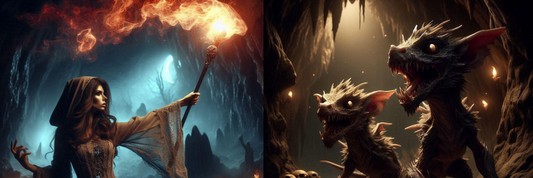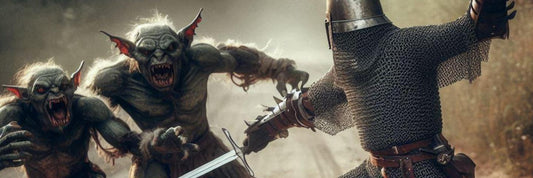Creating your first character in 5th Edition Dungeons and Dragons
Introduction
Welcome to the world of Dungeons & Dragons (D&D), where your imagination can take you on epic adventures and unforgettable journeys. One of the most exciting parts of D&D is creating your own character, a unique hero who will face challenges, explore new worlds, and grow throughout your campaign. This guide will help you navigate the character creation process, offering tips and encouragement to spark your creativity and make the experience enjoyable.
Step 1: Choose a Race
Your character's race determines their physical traits, cultural background, and innate abilities. D&D offers a variety of races, each with its own unique features and benefits. Here are some popular choices to consider:
- Humans: Versatile and adaptable, humans gain a bonus to all ability scores and have extra skill proficiencies. They are a great choice for new players due to their flexibility.
- Elves: Graceful and perceptive, elves have bonuses to Dexterity and keen senses. They also have the ability to see in the dark and resist charm and sleep magic.
- Dwarves: Sturdy and resilient, dwarves have bonuses to Constitution and are proficient with battleaxes, handaxes, light hammers, and warhammers. They also have resistance to poison.
- Halflings: Small and nimble, halflings have bonuses to Dexterity and an ability called "Lucky," which allows them to reroll a natural 1 on attack rolls, ability checks, or saving throws.
Each race has subraces that offer additional traits and abilities. For example, elves can be High Elves, Wood Elves, or Dark Elves (Drow), each with distinct features. Consider your character's background and personality when choosing a race. Do they hail from a noble lineage, or are they a wanderer from the wilds? Let your imagination run wild!
Step 2: Choose a Class
Your character's class defines their role in the party and their primary abilities. There are twelve core classes in D&D 5th Edition, each offering unique skills and playstyles:
- Barbarian: A fierce warrior with high hit points and the ability to enter a rage, increasing their damage output and resistance to damage.
- Bard: A versatile spellcaster and performer, bards use music and magic to inspire allies and hinder enemies.
- Cleric: A divine spellcaster with healing and protective spells, clerics are devoted to a deity and can channel divine power.
- Druid: A nature-based spellcaster with the ability to transform into animals, druids protect the natural world and wield powerful elemental magic.
- Fighter: A master of combat, fighters excel with weapons and armor, making them effective in battle.
- Monk: A martial artist who uses unarmed strikes and ki energy to perform extraordinary feats.
- Paladin: A holy warrior bound by a sacred oath, paladins combine combat prowess with divine spells.
- Ranger: A skilled tracker and hunter, rangers excel in wilderness survival and can cast nature spells.
- Rogue: A stealthy and dexterous adventurer, rogues are masters of sneak attacks and disarming traps.
- Sorcerer: A natural spellcaster who draws power from their bloodline or innate magical ability.
- Warlock: A spellcaster who gains power through a pact with a powerful entity, such as a demon, fey, or elder god.
- Wizard: A learned spellcaster who studies ancient tomes to master the arcane arts.
Each class has unique subclasses, chosen at 3rd level, that further specialize their abilities. For example, a wizard can choose to focus on a specific school of magic, while a fighter can become a champion, battle master, or eldritch knight. Think about what role you want to play in the party and choose a class that fits your vision.
Step 3: Determine Ability Scores
Ability scores are the foundation of your character's capabilities. There are six ability scores in D&D:
- Strength: Physical power and carrying capacity.
- Dexterity: Agility, reflexes, and balance.
- Constitution: Endurance, stamina, and overall health.
- Intelligence: Mental acuity, reasoning, and memory.
- Wisdom: Perception, insight, and intuition.
- Charisma: Personal magnetism, leadership, and force of personality.
You can determine your character's ability scores using one of the following methods:
- Standard Array: Assign the following scores to your abilities: 15, 14, 13, 12, 10, and 8. This method ensures balanced and fair scores.
- Point Buy: Distribute 27 points among your ability scores, with each score starting at 8. Higher scores cost more points, with a maximum of 15 before racial bonuses.
- Rolling: Roll four six-sided dice (4d6) and discard the lowest roll. Add the remaining three dice together to get an ability score. Repeat this process six times and assign the scores to your abilities.
Consider your character's class and race when assigning ability scores. For example, a fighter benefits from high Strength and Constitution, while a wizard needs high Intelligence and Dexterity. Don’t be afraid to create a character with unconventional abilities—sometimes, flaws can make a character more interesting and fun to play.
Step 4: Choose a Background
Your character's background adds flavor and provides additional skills, proficiencies, and starting equipment. Backgrounds also include feature traits that can help define your character's backstory and personality. Here are some common backgrounds:
- Acolyte: A religious servant with proficiency in Insight and Religion, as well as knowledge of temple services.
- Criminal: A former outlaw with proficiency in Deception and Stealth, along with a network of criminal contacts.
- Folk Hero: A commoner who rose to prominence, proficient in Animal Handling and Survival, with rustic hospitality.
- Noble: A member of the upper class with proficiency in History and Persuasion, and access to high society.
- Sage: A scholar with proficiency in Arcana and History, and access to a wealth of knowledge.
- Soldier: A military veteran with proficiency in Athletics and Intimidation, and familiarity with military hierarchy.
Each background comes with personality traits, ideals, bonds, and flaws that help flesh out your character. Use these to guide your roleplaying and bring depth to your character's interactions and decisions. For example, a noble might strive to restore their family's honor, while a criminal seeks redemption for past misdeeds.
Step 5: Select Equipment
Based on your character's class and background, and consulting with your Dungeon Master, you'll choose starting equipment. This can include weapons, armor, and adventuring gear. Each class provides a list of starting equipment options. For example:
- Fighter: A chain mail or leather armor, a martial weapon and shield or two martial weapons, a light crossbow and 20 bolts or two handaxes, a dungeoneer’s pack or explorer’s pack.
- Wizard: A quarterstaff or dagger, a component pouch or an arcane focus, a scholar’s pack or explorer’s pack, and a spellbook.
- Rogue: A rapier or a shortsword, a shortbow and quiver of 20 arrows or a shortsword, a burglar’s pack, dungeoneer’s pack, or explorer’s pack, leather armor, two daggers, and thieves' tools.
Your background also provides additional equipment, such as tools or trinkets. Consider your character's personality and backstory when choosing equipment. A noble might carry a signet ring and fine clothes, while a folk hero might have a shovel and a set of common clothes. Make sure your Dungeon Master is aware of any special items your character owns that may play a role in their character development.
Step 6: Choose Skills and Feats
Skills represent your character's ability to perform various tasks, such as sneaking, climbing, or persuading others. Each class and background provide proficiency in certain skills. For example, a rogue might be proficient in Stealth and Sleight of Hand, while a bard might excel in Performance and Persuasion.
In addition to skills, you can choose feats as your character levels up. Feats are special abilities that provide unique benefits and customization options. Some popular feats include:
- Alert: Increases your initiative and prevents you from being surprised.
- Great Weapon Master: Allows you to make a bonus attack when you score a critical hit or reduce a creature to 0 hit points.
- Lucky: Grants you three luck points, which you can use to roll an additional d20 and choose which result to use.
- Mobile: Increases your speed and prevents opportunity attacks when you make a melee attack.
Feats can greatly enhance your character's abilities and playstyle. Consider your character's role in the party and choose feats that complement their strengths and cover their weaknesses.
Step 7: Final Touches
Now that you've determined your character's race, class, ability scores, background, equipment, skills, and feats, it's time to add the finishing touches:
- Name: Give your character a name that reflects their race, culture, and personality. You can find inspiration from fantasy name generators or historical names.
- Alignment: Choose an alignment that represents your character's moral and ethical beliefs. The nine alignments range from Lawful Good to Chaotic Evil. Alignment helps guide your character's actions and decisions.
- Appearance: Describe your character's physical appearance, including their height, weight, eye color, hair color, and any distinguishing features. This helps bring your character to life and provides a visual reference for your fellow players.
- Personality Traits: Use the personality traits, ideals, bonds, and flaws from your background to develop your character's personality. These traits can provide motivation for your character's actions and create interesting roleplaying opportunities.
- Backstory: Create a backstory that explains your character's past and how they became an adventurer. Consider their family, upbringing, significant events, and relationships. A rich backstory adds depth to your character and can provide hooks for the Dungeon Master to incorporate into the campaign.
Encouragement for New Players
Creating your first D&D character is a journey of discovery and creativity. Here are some tips to make the process enjoyable and rewarding:
- Experiment: Don’t be afraid to try new things. Play a race or class that intrigues you, even if it’s outside your comfort zone. The more you experiment, the more you'll learn about what you enjoy in the game.
- Collaborate: Work with your fellow players and Dungeon Master to create characters that fit well together. Discuss your character's backstory and motivations to find connections and shared goals.
- Ask for Help: If you’re unsure about any part of the character creation process, ask experienced players or your Dungeon Master for guidance. They can provide valuable advice and help you avoid common pitfalls.
- Embrace Flaws: Flaws and imperfections can make your character more interesting and relatable. Embrace the quirks and weaknesses that make your character unique.
- Have Fun: Remember that D&D is a game, and the goal is to have fun. Don’t stress too much about making the perfect character. Enjoy the process and look forward to the adventures ahead.
Conclusion
Creating your first character in Dungeons & Dragons 5th Edition is an exciting and rewarding experience. By following this guide, you'll be well on your way to bringing a unique and memorable hero to life. Whether you’re a fierce warrior, a cunning rogue, or a wise spellcaster, your character will grow, evolve, and face incredible challenges as you embark on epic adventures. So grab your dice, unleash your imagination, and get ready to explore the fantastic world of D&D!




